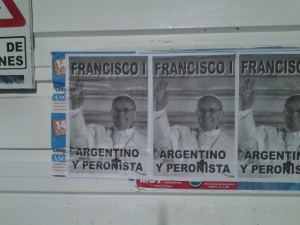Uki Goñi has written an article for the New York Times on Pope Francis’s Peronist roots.Here’s an extract:
Less known is that Perón took his cue from the politicized Catholic leaders of ’30s Argentina. Church leaders back then sought the integration of Argentina’s new working class by promoting radical labor reforms. Bishops addressed some of the country’s first large rallies of workers, and Perón cut his teeth speaking at meetings of the Círculos Católicos de Obreros (Catholic Worker Circles).
Perón’s alliance with the bishops was sealed when the 1943-46 military regime, in which he was vice president, made Catholic education obligatory in Argentina’s previously secular public schools. The process culminated in 1944 when Perón decorated a statue of the Virgin Mary with a military sash and appointed her a “general,” accompanied by a 21-gun salute.
Now that’s a nice touch, but, to be fair, it’s worth noting that Perón turned sharply against the church in the later part of his first stretch in power.
Back to Goñi:
“Neither Marxists nor Capitalists. Peronists!” was the chant of Perón’s supporters. And it was borrowing from the church’s political thinking that enabled Perón to found his “Third Way.”
It’s perhaps a little more complicated than that. Perón made a careful study of the politics of inter-war Europe (he was based there for a while) and essentially concluded that Argentina could learn most from the corporatism of fascist Italy, a corporatism that was itself partly a mutation of some of the political and economic ideas set out in De Rerum Novarum, a hugely influential late-19th-century encyclical.
And Perón was not the first to believe that he had found a “third way” between socialism and capitalism, a notion that was the conceit of a number of Roman Catholic intellectuals in the early 20th century, not least G. K. Chesterton, a rather better writer than economist (interestingly, shortly before he became pope, the then Cardinal Bergoglio approved the wording of a private prayer calling for Chesterton’s canonization).
Francis has also borrowed quite a bit of Peronist style too. Reading an article in CapX by Federico N. Fernández about the upcoming Argentine election, this passage made me think of the way Francis has of scattering villains, straw men and hints of conspiracy in some of his more overtly political speeches:
The [Peronist] Kirchner couple has had three consecutive terms in office since 2003. In these twelve years they have isolated Argentina from the rest of the world and their hate mongering tactics have fractured and polarized society.
Following the intellectual guidance of Ernesto Laclau (1935–2014), the Kirchners have run their administration on the basis of constant conflict and the “friend / foe” logic…The Kirchners divided society between “the people” and different enemies – a kind of satanic anti-people who is constantly plotting to undermine the achievements of the “popular government.”
In describing Peronist rule, Goñi writes that “the populist general upended Argentina’s class structure by championing the country’s downtrodden”. There’s quite a bit to that (although Perón’s policies should also be read as an expression of Argentine caudillismo), but what he does not say is that Peronism ended in economic disaster, a fact that has not stopped Pope Francis from peddling a very similar brand of snake oil for reasons, I suspect, that do not do him credit.
Links
http://www.nationalreview.com/corner/422510/pope-and-peronism-andrew-stuttaford
http://www.sconews.co.uk/news/30679/pope-gives-blessing-to-cause-for-chesterton/

